Lenovo Mobile Communication Technology A2016B30 Mobile Phone User Manual
Lenovo Mobile Communication Technology Ltd. Mobile Phone
User Manual

Quick Start Guide
Read this guide carefully before using your smartphone.
Lenovo Vibe B
Lenovo A2016b30

Reading before using your smartphone
For your safety
Before assembling, charging or using your mobile device for the rst
time, please read the important product safety and legal information
provided with your product.
Usage
This phone supports apps and services that may use a lot of data, so
make sure your data plan meets your needs. Contact your service
provider for details. Certain apps and features may not be available in
all countries.
Electrical requirements
Battery: 7.6 Wh 2000 mAh
Adapter: AC
Entrance: 100-240 V AC 50/60 Hz 0.13 A
Exit: 5.0 V DC 1.0A
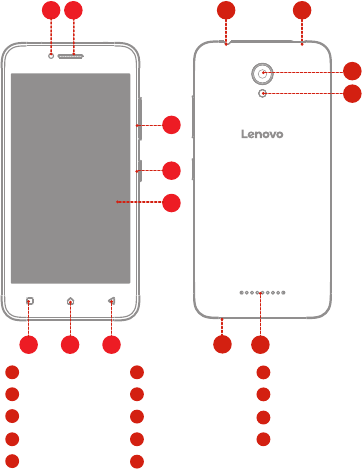
First glance
Volume buttons
3
1Receiver
2
Touch screen 6
Front-facing camera
4On/Off button 5
Multitask button 9
Back button
7Home button 8
Speaker
12
Headset connector
10 Micro USB connector 11 Flash
13 Microphone
14
Rear-facing camera
12
11
109
13
14
7
86
5
4
3
12
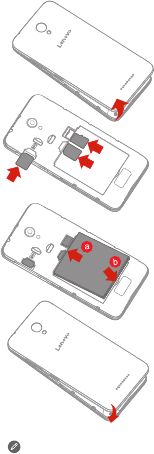
Preparing your smartphone
You must insert the Micro-SIM card provided by your carrier to use cellular
services. Set up your smartphone as shown.
Always turn off your smartphone rst before you insert or remove a
Micro-SIM card. Insert or remove a Micro-SIM card with your
smartphone on may damage your Micro-SIM card or smartphone
permanently.
Step 1. Open the back cover.
Step 2. Insert the Micro-SIM
cards and the microSD
card.
Step 3. Install the battery.
a. Align the battery
connectors on the battery
with the pins in the
battery compartment.
b. Push the battery down
into place.
Step 4. Install the back cover.
microSD
SIM
SIM
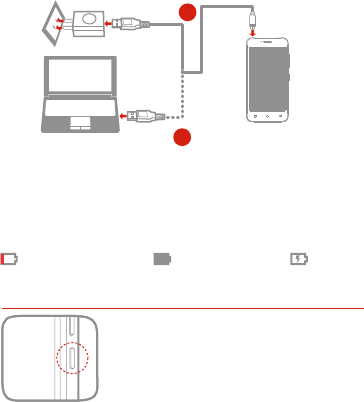
2
1
Low battery power Fully charged Charging
Charge the battery as shown.
Turning on or turning off your smartphone
Turn on: Press and hold the On/Off button until
the Lenovo logo appears.
Turn of f: Press and hold the On/Off button for a
few seconds, then tap Power off and OK.
Method 1.
Method 2.
Connect your smartphone to a power outlet using the
cable and USB power adapter that come with your
smartphone.
Connect your smartphone to a computer using the cable
that comes with your smartphone.
Charging the battery
You must insert the Micro-SIM card provided by your carrier to use cellular
services. Set up your smartphone as shown.
Federal Communication Commission Interference Statement
This device complies with part 15 of the FCC Rules. Operation is subject to the
following two conditions: (1) This device may not cause harmful interference, and (2)
this device must accept any interference received, including interference that may cause
undesired operation.
This device has been tested and found to comply with the limits for a Class B digital
device, pursuant to Part 15 of the FCC Rules. These limits are designed to provide
reasonable protection against harmful interference in a residential installation. This
equipment generates, uses, and can radiate radio frequency energy, and, if not installed
and used in accordance with the instructions, may cause harmful interference to radio
communications. However, there is no guarantee that interference will not occur in a
particular installation If this equipment does cause harmful interference to radio or
television reception, which can be determined by turning the equipment off and on, the
user is encouraged to try to correct the interference by one or more of the following
measures:
Reorient or relocate the receiving antenna.
Increase the separation between the equipment and receiver.
Connect the equipment into an outlet on a circuit different from that to which
the receiver is connected.
Consult the dealer or an experienced radio/TV technician for help.
FCC Caution:
Any Changes or modifications not expressly approved by the party
responsible for compliance could void the user‘s authority to operate the equipment.
The antenna(s) used for this transmitter must not be co-located or operating
in conjunction with any other antenna or transmitter.
The country code selection is for non-US model only and is not available to
all US model. Per FCC regulation, all WiFi product marketed in US must fixed to US
operation channels only.

RF Exposure Information (SAR)
This device meets the government’s requirements for exposure to radio waves.
This device is designed and manufactured not to exceed the emission limits for
exposure to radio frequency (RF) energy set by the Federal Communications
Commission of the U.S. Government.
The exposure standard for wireless device employs a unit of measurement known as
the Specific Absorption Rate, or SAR. The SAR limit set by the FCC is 1.6W/kg. *Tests
for SAR are conducted using standard operating positions accepted by the FCC with
the device transmitting at its highest certified power level in all tested frequency bands.
Although the SAR is determined at the highest certified power level, the actual SAR
level of the device while operating can be well below the maximum value. This is
because the device is designed to operate at multiple power levels so as to use only the
poser required to reach the network. In general, the closer you are to a wireless base
station antenna, the lower the power output.
The highest SAR value for the model device as reported to the FCC when tested for use
at the ear is 1.00 W/kg and when worn on the body, as described in this user guide, is
1.31 W/kg (Body-worn measurements differ among device models, depending upon
available accessories and FCC requirements.)
While there may be differences between the SAR levels of various devices and at
various positions, they all meet the government requirement.
The FCC has granted an Equipment Authorization for this model device with all
reported SAR levels evaluated as in compliance with the FCC RF exposure guidelines.
SAR information on this model device is on file with the FCC and can be found
under the Display Grant section of www.fcc.gov/oet/ea/fccid after searching on FCC
ID: YCNA2016B30.
For body worn operation, this device has been tested and meets the FCC RF exposure
guidelines for use with an accessory that contains no metal and be positioned a
minimum of 1.0cm from the body. Use of other accessories may not ensure
compliance with FCC RF exposure guidelines. If you do not use a body-worn
accessory and are not holding the device at the ear, position the handset a minimum of
1.0cm from your body when the device is switched on.

Specic Absorption Rate (FCC)
YOUR MOBILE DEVICE MEETS FCC LIMITS FOR EXPOSURE TO
RADIO WAVES.
Your mobile device is a radio transmitter and receiver. It is designed
not to exceed the limits for exposure to radio waves (radio frequency
electromagnetic elds) adopted by the Federal Communications
Commission (FCC). These limits include a substantial safety margin
designed to assure the safety of all persons, regardless of age and
health.
The radio wave exposure guidelines use a unit of measurement known
as the Specic Absorption Rate, or SAR. The SAR limit for mobile
devices is 1.6 W/kg.
Tests for SAR are conducted using standard operating positions with
the device transmitting at its highest certied power level in all tested
frequency bands. The highest SAR values under the FCC guidelines
for your device model are listed below:
During use, the actual SAR values for your device are usually well
below the values stated. This is because, for purposes of system
efciency and to minimize interference on the network, the operating
power of your mobile device is automatically decreased when full
power is not needed for the call. The lower the power output of the
device, the lower its SAR value.
If you are interested in further reducing your RF exposure then you can
easily do so by limiting your usage or simply using a hands-free kit to
keep the device away from the head and body.
Additional information can be found at www.lenovo.com.
1.31W/kg
1.00W/kg
Head SAR
Body-worn SAR
GSM 850 MHz, Wi-Fi, Bluetooth
GSM 850 MHz, Wi-Fi, Bluetooth
Copyright and trademarks
Certain features, services and applications are network dependent
and may not be available in all areas; additional terms, conditions
and/or charges may apply. Contact your service provider for details.
All features, functionality, and other product specications, as well as
the information contained in this guide, are based upon the latest
available information and believed to be accurate at the time of
printing. Lenovo reserves the right to change or modify any
information or specications without notice or obligation.
Note: The images in this guide are examples only.
Lenovo and the Lenovo logo are trademarks of Lenovo in the United
States, other countries, or both.
Android, Google and other trademarks are owned by Google Inc. The
Android robot is reproduced or modied from work created and
shared by Google and used according to terms described in the
Creative Commons 3.0 Attribution License. All other product or
service names are the property of their respective owners.
© Copyright Lenovo 2016.
Product ID: Lenovo Vibe B (Model Lenovo A2016b30)
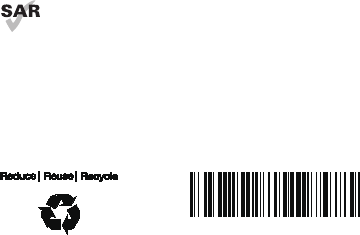
XXXXXXXXXX
Printed in China
V1.0_20160617
Learning more
Getting support
To get support on network service and billing, contact your wireless
network operator. To learn how to use your smartphone and view its
technical specications, go to http://support.lenovo.com.
Downloading publications
To obtain the latest smartphone manuals, go to:
http://support.lenovo.com
Accessing your User Guide
Your User Guide contains detailed information about your
smartphone. To access your User Guide, go to
http://support.lenovo.com and follow the instructions on the screen.
This product meets the applicable national or
international RF exposure guidance (SAR guideline)
when used normally against your head or, when worn
or carried, at a distance of 1 cm from the body. The SAR
guideline includes a considerable safety margin designed to
assure the safety of all persons, regardless of age and health.
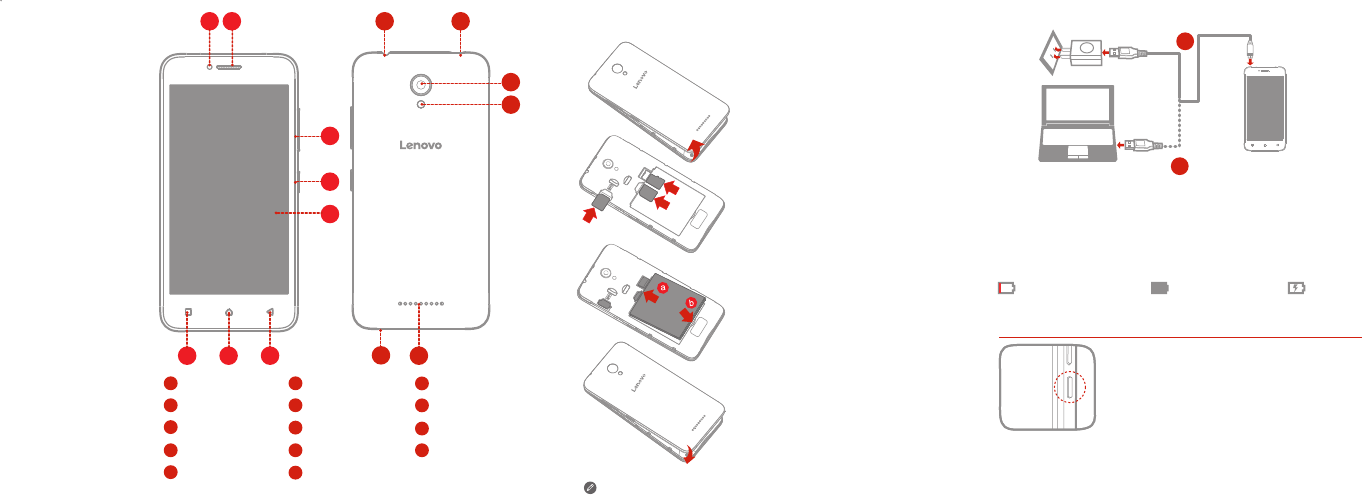
2
1
Low battery power Fully charged Charging
Charge the battery as shown.
Turning on or turning off your smartphone
Turn on: Press and hold the On/Off button until
the Lenovo logo appears.
Turn of f: Press and hold the On/Off button for a
few seconds, then tap Power off and OK.
Method 1.
Method 2.
Connect your smartphone to a power outlet using the
cable and USB power adapter that come with your
smartphone.
Connect your smartphone to a computer using the cable
that comes with your smartphone.
Charging the batteryPreparing your smartphone
You must insert the Micro-SIM card provided by your carrier to use cellular
services. Set up your smartphone as shown.
Always turn off your smartphone rst before you insert or remove a
Micro-SIM card. Insert or remove a Micro-SIM card with your
smartphone on may damage your Micro-SIM card or smartphone
permanently.
First glance
Volume buttons
3
1Receiver
2
Touch screen 6
Front-facing camera
4On/Off button 5
Multitask button 9
Back button
7Home button 8
Speaker
12
Headset connector
10 Micro USB connector 11 Flash
13 Microphone
14
Rear-facing camera
12
11
10
9
13
14
7
86
5
4
3
12
Step 1. Open the back cover.
Step 2. Insert the Micro-SIM
cards and the microSD
card.
Step 3. Install the battery.
a. Align the battery
connectors on the battery
with the pins in the
battery compartment.
b. Push the battery down
into place.
Step 4. Install the back cover.
microSD
SIM
SIM
Reading before using your smartphone
For your safety
Before assembling, charging or using your mobile device for the rst
time, please read the important product safety and legal information
provided with your product.
Usage
This phone supports apps and services that may use a lot of data, so
make sure your data plan meets your needs. Contact your service
provider for details. Certain apps and features may not be available in
all countries.
Electrical requirements
Battery: 7.6 Wh 2000 mAh
Adapter: AC
Entrance: 100-240 V AC 50/60 Hz 0.13 A
Exit: 5.0 V DC 1.0A

XXXXXXXXXX
Printed in China
V1.0_20160617
Learning more
Getting support
To get support on network service and billing, contact your wireless
network operator. To learn how to use your smartphone and view its
technical specications, go to http://support.lenovo.com.
Downloading publications
To obtain the latest smartphone manuals, go to:
http://support.lenovo.com
Accessing your User Guide
Your User Guide contains detailed information about your
smartphone. To access your User Guide, go to
http://support.lenovo.com and follow the instructions on the screen.
This product meets the applicable national or
international RF exposure guidance (SAR guideline)
when used normally against your head or, when worn
or carried, at a distance of 1.0cm from the body. The SAR
guideline includes a considerable safety margin designed to
assure the safety of all persons, regardless of age and health.
Copyright and trademarks
Certain features, services and applications are network dependent
and may not be available in all areas; additional terms, conditions
and/or charges may apply. Contact your service provider for details.
All features, functionality, and other product specications, as well as
the information contained in this guide, are based upon the latest
available information and believed to be accurate at the time of
printing. Lenovo reserves the right to change or modify any
information or specications without notice or obligation.
Note: The images in this guide are examples only.
Lenovo and the Lenovo logo are trademarks of Lenovo in the United
States, other countries, or both.
Android, Google and other trademarks are owned by Google Inc. The
Android robot is reproduced or modied from work created and
shared by Google and used according to terms described in the
Creative Commons 3.0 Attribution License. All other product or
service names are the property of their respective owners.
© Copyright Lenovo 2016.
Product ID: Lenovo Vibe B (Model Lenovo A2016b30)
Specic Absorption Rate (FCC)
YOUR MOBILE DEVICE MEETS FCC LIMITS FOR EXPOSURE TO
RADIO WAVES.
Your mobile device is a radio transmitter and receiver. It is designed
not to exceed the limits for exposure to radio waves (radio frequency
electromagnetic elds) adopted by the Federal Communications
Commission (FCC). These limits include a substantial safety margin
designed to assure the safety of all persons, regardless of age and
health.
The radio wave exposure guidelines use a unit of measurement known
as the Specic Absorption Rate, or SAR. The SAR limit for mobile
devices is 1.6 W/kg.
Tests for SAR are conducted using standard operating positions with
the device transmitting at its highest certied power level in all tested
frequency bands. The highest SAR values under the FCC guidelines
for your device model are listed below:
During use, the actual SAR values for your device are usually well
below the values stated. This is because, for purposes of system
efficiency and to minimize interference on the network, the operating
power of your mobile device is automatically decreased when full
power is not needed for the call. The lower the power output of the
device, the lower its SAR value.
If you are interested in further reducing your RF exposure then you
can easily do so by limiting your usage or simply using a hands-free kit
to keep the device away from the head and body.
Additional information can be found at www.lenovo.com.
1.31W/kg
1.00W/kg
Head SAR
Body-worn SAR
GSM 850, Wi-Fi, Bluetooth
GSM 850, Wi-Fi, Bluetooth
Quick Start Guide
Read this guide carefully before using your smartphone.
Lenovo Vibe B
Lenovo A2016b30